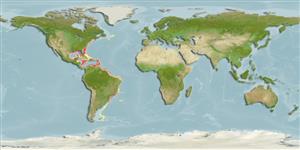Elasmobranchi (squali e razze) (sharks and rays) >
Rajiformes (Skates and rays) >
Rajidae (Skates)
Etymology: Dactylobatus: Greek, daktyleys, -eos = a kind of grey mullet + Greek, batis = a kind of ray (Ref. 45335).
Eponymy: Dr Robert Selbie Clark (1882–1950) was a British marine zoologist and explorer who was a member of Shackleton’s Imperial Transantarctic Expedition (1914–1917), being one of those left on Elephant Island when Shackleton sailed in an open boat to [...] (Ref. 128868), visit book page.
Environment: milieu / climate zone / distribuzione batimetrica / distribution range
Ecologia
marino batidemersale; distribuzione batimetrica 475 - 1000 m (Ref. 28767). Deep-water; 5°S - 31°N, 97°W - 33°W (Ref. 114953)
Western Central Atlantic: northern Gulf of Mexico (Ref. 13608) to South Carolina (Ref. 114953) and northern coast of South America (Ref. 5217).
Size / Peso / Age
Maturità: Lm ? range ? - ? cm
Max length : 59.0 cm TL maschio/sesso non determinato; (Ref. 13608); 69.0 cm WD (female)
Inhabits mud-bottom habitat on the upper slope, generally in waters deeper than 350 meters. Mainly feeds on small bony fishes (Ref. 114953). Stomach contents include one specimen of Mullus argentinae, remains of a teleost fish and predominance of Myctophidae fishes. Sympatric with other chondrichthyans, Etmopterus bigelowi, Squalus aff. blainvillei, and Dipturus leptocauda (Ref. 56543). Oviparous (Ref. 50449). Eggs have horn-like projections on the shell (Ref. 205).
Life cycle and mating behavior
Maturità | Riproduzione | Deposizione | Uova | Fecundity | Larve
Oviparous, paired eggs are laid. Embryos feed solely on yolk (Ref. 50449). Eggs have horn-like projections on the shell (Ref. 205).
McEachran, J.D. and K.A. Dunn, 1998. Phylogenetic analysis of skates, a morphologically conservative clade of elasmobranchs (Chondrichthyes: Rajidae). Copeia 1998(2):271-290. (Ref. 27314)
IUCN Red List Status (Ref. 130435: Version 2025-1)
Threat to humans
Harmless
Human uses
Strumenti
Special reports
Download XML
Fonti Internet
Estimates based on models
Preferred temperature (Fonte Biblio.
123201): 5.5 - 13, mean 8 °C (based on 76 cells).
Phylogenetic diversity index (Fonte Biblio.
82804): PD
50 = 0.7500 [Uniqueness, from 0.5 = low to 2.0 = high].
Bayesian length-weight: a=0.00302 (0.00141 - 0.00645), b=3.24 (3.07 - 3.41), in cm total length, based on LWR estimates for this (Sub)family-body shape (Ref.
93245).
Trophic level (Fonte Biblio.
69278): 4.5 ±0.80 se; based on food items.
Resilienza (Fonte Biblio.
120179): Basso, tempo minimo di raddoppiamento della popolazione 4.5 - 14 anni (Fec assumed to be <100).
Fishing Vulnerability (Ref.
59153): Low vulnerability (22 of 100).
🛈
